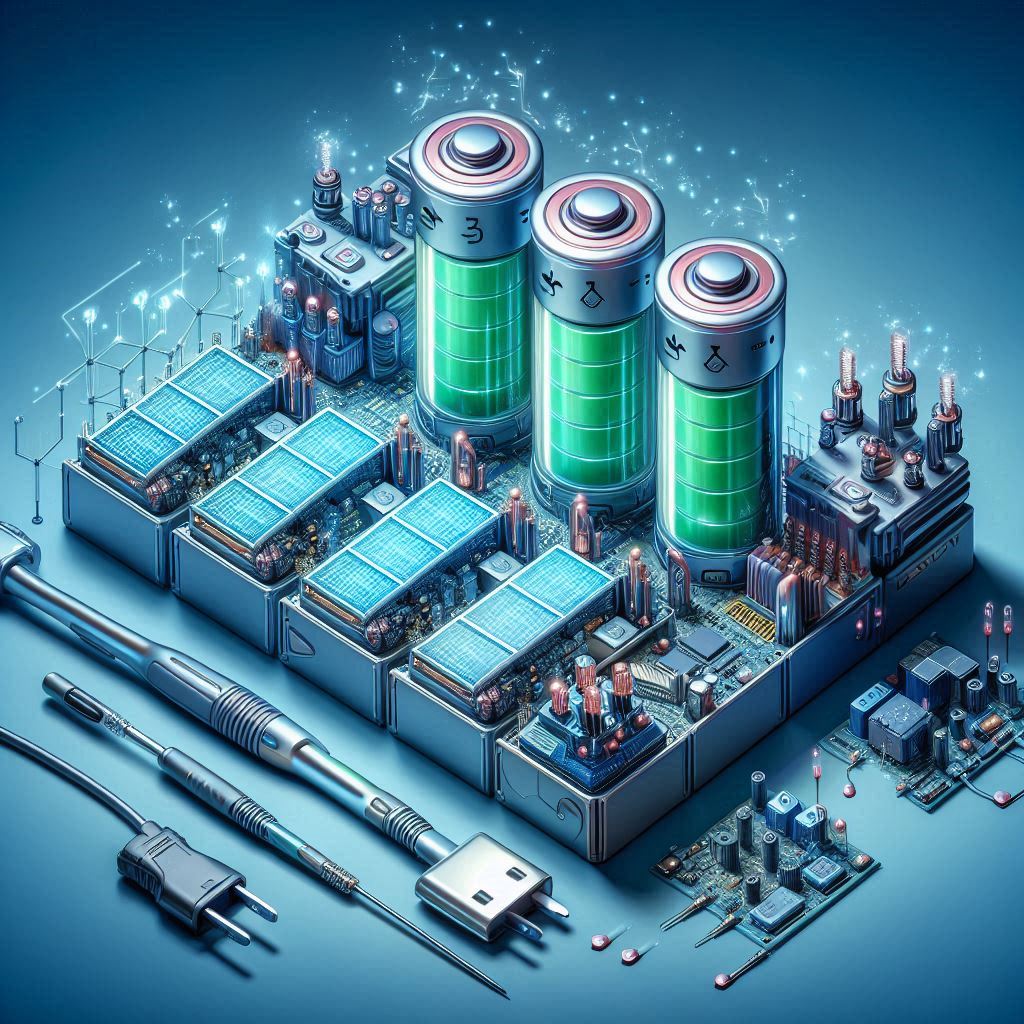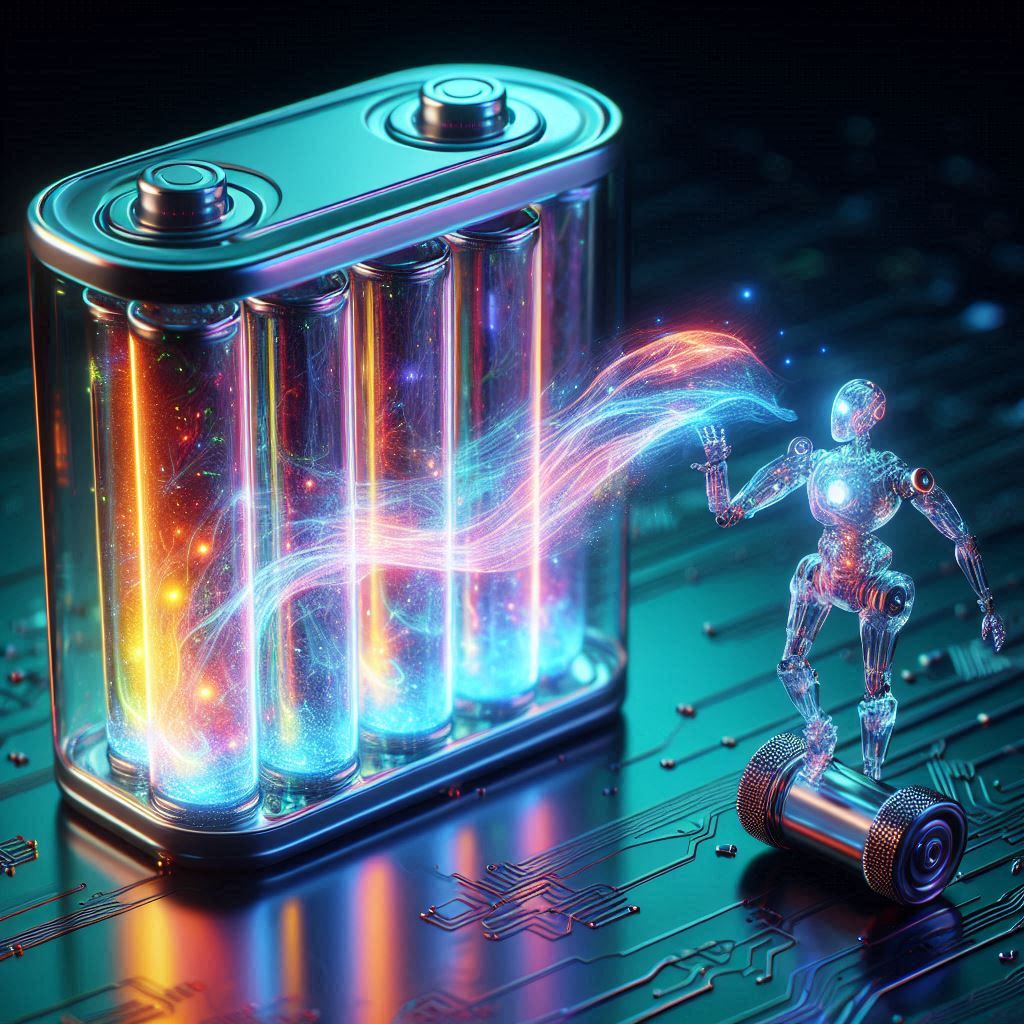Contents
- 1 Unveiling the Potential of Advanced Energy Storage
- 2 Prof. Aécio D’Silva, Ph.D. AquaUniversity
- 3 Discover the five groundbreaking battery technologies poised to redefine energy storage and power our lives, from electric vehicles to smartphones.
- 4 Solid-State Batteries: The Next Leap in Energy Storage
- 5 Lithium-Sulfur Batteries: The Lightweight Contender
- 6 Sodium-Ion Batteries: The Cost-Effective Alternative
- 7 Magnesium Batteries: Unlocking High-Energy Storage
- 8 Vanadium Flow Batteries: The Grid-Scale Solution
- 9 Exploring Other Emerging Technologies
- 10
- 11 Tesla’s efforts in developing new groundbreaking battery technologies
- 12 Tesla’s Gigafactory Texas.
- 13
- 14 Battery Technology Expanding more about solid-state batteries
- 15
- 16 Battery Technology – Toyota’s efforts with solid-state batteries
- 17 What are the advantages of solid-state batteries for Toyota’s EVs?
- 18 Battery Technology – What other automakers are investing in solid-state batteries?
- 19
- 20 Battery Technology – ProLogium and QuantumScape Technologies
- 21
- 22 Battery Technology – What are the main differences between ProLogium and QuantumScape batteries?
Unveiling the Potential of Advanced Energy Storage
Prof. Aécio D’Silva, Ph.D.
AquaUniversity
Discover the five groundbreaking battery technologies poised to redefine energy storage and power our lives, from electric vehicles to smartphones.
Battery Technology – In the quest for sustainable and efficient energy solutions, battery technology stands at the forefront of innovation. With the rapid advancement of electric vehicles (EVs) and the ever-growing demand for longer-lasting smartphones, the need for more powerful, durable, and environmentally friendly batteries has never been greater. This blog delves into five cutting-edge battery technologies that are set to transform the landscape of energy storage.
Solid-State Batteries: The Next Leap in Energy Storage
Solid-state batteries represent a significant step forward in battery technology. By replacing the liquid electrolyte with a solid counterpart, these batteries offer increased energy density and improved safety features. This makes them an ideal candidate for use in EVs, where range and reliability are paramount. Later in this post, we will expand a little more on this innovative technology.
Lithium-Sulfur Batteries: The Lightweight Contender
Lithium-sulfur (Li-S) batteries boast a high energy density and a lower environmental impact than traditional lithium-ion batteries. Their lightweight nature holds promise for portable electronics, potentially extending the battery life of devices without adding bulk.
Sodium-Ion Batteries: The Cost-Effective Alternative
Sodium-ion batteries have emerged as a cost-effective and abundant alternative to lithium-ion batteries. With similar performance metrics, they could provide a more accessible solution for large-scale energy storage systems, particularly in regions where lithium is scarce.
Magnesium Batteries: Unlocking High-Energy Storage
Magnesium batteries offer a potential breakthrough with their high-energy storage capabilities. As researchers overcome existing challenges, these batteries could offer a viable option for both EVs and grid storage applications.
Vanadium Flow Batteries: The Grid-Scale Solution
Vanadium flow batteries excel in grid-scale energy storage. Their ability to provide long-duration, stable power output makes them suitable for balancing renewable energy sources and ensuring a consistent energy supply.
Exploring Other Emerging Technologies
Beyond these five, there are other emerging battery technologies, such as zinc-based and bio-inspired batteries, that are also making waves in the industry. These innovations continue to push the boundaries of what’s possible in energy storage.
Tesla’s efforts in developing new groundbreaking battery technologies
Tesla is at the forefront of battery technology innovation, with several key developments that are shaping the future of electric vehicles (EVs). Here’s an overview of Tesla’s efforts:
- 4680 Battery Cell: Tesla has developed a new battery cell format known as the 4680, which is expected to significantly reduce battery costs and improve vehicle performance. The company has been working on bringing this to volume production and has made advancements in cell design, anode and cathode materials, and manufacturing processes.
- Lithium Refinery: Tesla plans to start commissioning a lithium refinery in Corpus Christi, Texas, which will use a sulfate-free refining process. This process is more cost-effective, environmentally friendly, and produces a beneficial byproduct for construction materials.
- Cathode Factory: At Gigafactory Texas, Tesla is installing equipment for a new cathode building to begin production before the end of the year. This includes a lower-cost, zero wastewater precursor process for cathode production.
- Solid-State Batteries: Tesla is also researching and developing solid-state batteries, which promise higher energy density and faster charging times compared to current lithium-ion batteries.
- Sustainable Practices: Tesla is committed to sustainable battery production, implementing closed-loop recycling for battery materials to reduce waste and conserve resources.
These efforts demonstrate Tesla’s commitment to advancing battery technology, which is crucial for achieving its goal of producing more affordable and sustainable electric cars.
Tesla’s Gigafactory Texas.
Gigafactory Texas, also known as Giga Texas or Giga Austin, is a significant Tesla manufacturing facility located in Austin, Texas. Here are some key details about the Gigafactory:
- Global Headquarters: Gigafactory Texas serves as Tesla’s global headquarters and is a central hub for Tesla’s manufacturing in the United States.
- Size and Scale: The facility covers 2,500 acres along the Colorado River, with over 10 million square feet of factory floor. It’s one of the largest manufacturing facilities in the country by size and volume.
- Production: The factory is responsible for producing the Tesla Model Y and will be the home of the upcoming Cybertruck. It’s designed to meet the growing demand for Tesla vehicles in the Eastern United States.
- Employment: As of 2023, Tesla employs over 20,000 people at the factory and expects to eventually have a staff of 60,000 as production ramps up.
- Construction and Operation: Construction of the Gigafactory began in July 2020, and limited production of the Model Y started before the end of 2021. The initial deliveries of vehicles built at the factory took place at an opening party called “Cyber Rodeo” on April 7, 2022.
- Innovation: The Gigafactory is a state-of-the-art facility, incorporating advanced manufacturing processes and technologies to produce vehicles quickly, efficiently, and safely.
- Sustainability: Tesla’s focus on sustainability is evident in the Gigafactory’s operations, with efforts to minimize environmental impact and implement sustainable practices throughout the production process.
Gigafactory Texas is a testament to Tesla’s commitment to innovation, sustainability, and the future of electric vehicles.
Battery Technology Expanding more about solid-state batteries
As the name suggests, a solid-state battery is a battery where all components are solid. Rechargeable batteries, like lithium-ion batteries, typically consist of two electrodes (a cathode and an anode) made of metal, with a liquid electrolyte filling the space between them. In contrast, solid-state batteries use a solid electrolyte.
The solid electrolyte is expected to enable batteries with larger capacities and higher outputs than lithium-ion batteries. Additionally, solid electrolytes offer safety advantages over their liquid counterparts, making solid-state batteries appealing for use in electric vehicles and other applications.
If practical, solid-state batteries could offer numerous benefits. Currently, various companies are competing to develop these batteries and achieve mass production for widespread distribution.
Unquestionably, solid-state batteries are a promising advancement in battery technology, offering several benefits over traditional lithium-ion batteries. Here’s a deeper look into their features:
High Energy Density
Solid-state batteries use a solid electrolyte instead of the liquid or gel polymer found in conventional batteries. This allows for a much higher energy density, meaning they can store more energy in the same amount of space. Thin-film types can reach 300–900 Wh/kg, while bulk types offer 250–500 Wh/kg.
Enhanced Safety
The solid electrolyte is non-flammable, which significantly reduces the risk of fires and makes solid-state batteries safer for consumer electronics and electric vehicles.
Longevity
These batteries have impressive cycle durability, ranging from 10,000 to 100,000 cycles. This means they can be charged and discharged many times over without losing significant capacity.
Operating Temperature Range
Solid-state batteries can operate over a wide temperature range, from -50 °C to 125 °C, which is beneficial for various applications, including extreme environments.
Material Innovation
Materials proposed for solid electrolytes include ceramics (e.g., oxides, sulfides, phosphates), and solid polymers. These materials contribute to the batteries’ overall performance and safety.
Current Applications and Future Potential
While solid-state batteries are currently found in niche applications like pacemakers and RFID devices, their potential for use in electric vehicles and portable electronics is vast. Companies like Toyota are working towards commercializing solid-state batteries for electric cars, aiming for a range of 1200 kilometers with a charging time of just 10 minutes.
Challenges
Despite their advantages, solid-state batteries face challenges in energy and power density, durability, material costs, sensitivity, and stability. Overcoming these challenges is crucial for their widespread adoption.
In summary, solid-state batteries represent a significant leap forward in energy storage technology. They promise to deliver safer, longer-lasting, and more efficient power for a range of applications, from EVs to smartphones. As research and development continue, we can expect to see more of these batteries powering our future.
Battery Technology – Toyota’s efforts with solid-state batteries
Toyota has been actively pursuing the development of solid-state batteries, aiming to revolutionize the electric vehicle (EV) market with this technology. Here are some key points about Toyota’s efforts:
- Collaboration for Mass Production: Toyota has partnered with Idemitsu Kosan Co., Ltd. to develop mass-production technology for solid electrolytes, which are crucial for solid-state batteries. They aim to ensure the successful commercialization of these batteries by 2027-28.
- Technological Breakthrough: Toyota claims to have made a significant breakthrough in solid-state battery technology, finding a new material that addresses longevity issues, which has been a major challenge in the past.
- Enhanced EV Performance: With the new solid-state batteries, Toyota is targeting a 20% improvement in cruising range and a 10-minute quick charge, which would be a substantial enhancement over current EV capabilities.
- Future Goals: Toyota’s plans include EVs with a range of up to 932 miles and less than 10-minute charging times, setting a new standard for the industry.
- Focus on Sustainability: The move towards solid-state batteries is part of Toyota’s broader strategy to pivot from a hybrid-centric approach to a focus on advanced battery technologies and EVs.
Toyota’s commitment to solid-state battery technology reflects its dedication to innovation and sustainability in the automotive industry. The company’s efforts could lead to significant improvements in EV range, charging times, and overall performance, making electric vehicles more appealing to a broader range of consumers.
What are the advantages of solid-state batteries for Toyota’s EVs?
Solid-state batteries offer several advantages for Toyota’s electric vehicles (EVs), which include:
- Greater Energy Density: Solid-state batteries have a higher energy density compared to traditional lithium-ion batteries. This means Toyota’s EVs can store more energy, leading to a longer driving range on a single charge.
- Faster Charging Times: These batteries can be charged much quicker than conventional batteries. Toyota is targeting charging times of less than 10 minutes, which is comparable to refueling times for gas-powered vehicles.
- Increased Electric Range: With solid-state batteries, Toyota’s EVs could achieve a range of up to 932 miles, significantly greater than any gas-powered car today and most current EVs.
- Improved Safety: The solid electrolyte in solid-state batteries is non-flammable, reducing the risk of fires and enhancing the overall safety of the vehicle.
- Lighter Weight: The absence of a liquid electrolyte could potentially lead to a lighter battery, contributing to the overall reduction in vehicle weight and improved efficiency.
- Higher Performance: Toyota’s solid-state batteries are expected to offer a 20% increase in range, with a significant reduction in cost, and the ability to achieve a substantial state of charge in under 30 minutes.
These advantages position Toyota to make a significant impact on the EV market, offering consumers vehicles that are safer, more efficient, and more convenient to use.
Battery Technology – What other automakers are investing in solid-state batteries?
Several automakers are investing in solid-state battery technology, recognizing its potential to enhance electric vehicle (EV) performance. Here are some of the key players:
- Mercedes-Benz: They have partnered with ProLogium, a Taiwanese company specializing in solid-state batteries, and are working towards electrifying their lineup by 2030.
- Volkswagen: In collaboration with QuantumScape, Volkswagen is developing solid-state batteries and aims to have EVs powered by this technology by 2024.
- BMW: BMW has invested in Solid Power, a solid-state battery startup, as part of their strategy to reduce the cost of EVs by investing in more affordable and powerful batteries.
- Ford: Alongside BMW, Ford is leading an investment round in Solid Power, showcasing their commitment to the development of solid-state batteries.
- General Motors: GM has a development agreement with SolidEnergy Systems (SES) of Singapore, aiming to produce a battery for electric cars by 2023.
These investments indicate a strong belief in the future of solid-state batteries and their role in the next generation of EVs. Automakers are racing to overcome the technical challenges and bring these batteries to market, promising a new era of electric mobility.
Battery Technology – ProLogium and QuantumScape Technologies
ProLogium Technology
ProLogium Technology is a Taiwanese company established in 2006, specializing in the research, development, and manufacturing of solid-state batteries, particularly lithium ceramic batteries. Here are some key points about ProLogium:
- Innovation and Production: ProLogium is known for its innovative approach to next-generation battery solutions, catering to electric vehicles, consumer markets, and industrial applications.
- Mass Production: It is the only solid-state battery manufacturer that has reached mass production, providing thousands of solid-state battery sample cells to global car manufacturers for testing and module development.
- Global Partnerships: ProLogium has signed cooperation agreements with several Chinese electric vehicle manufacturers and an MOU with Vietnamese car OEM Vinfast to produce solid-state batteries for electric cars in Vietnam.
- European Expansion: In May 2023, ProLogium announced the opening of a primary international production center in Dunkirk, France, after considering several European locations.
- Investments and Valuation: The company has raised significant funding, placing its valuation between $2-$3 billion, with investors including Mercedes-Benz and VinFast.
QuantumScape Technology
QuantumScape, based in San Jose, California, is an American company founded in 2010 with a mission to revolutionize energy storage through solid-state lithium-metal battery technology. Key aspects of QuantumScape include:
- Battery Technology: QuantumScape’s solid-state batteries are designed for greater energy density, faster charging, and enhanced safety, supporting the transition to a lower-carbon future.
- Innovative Design: The company developed the industry’s first anode-less cell design, which simplifies manufacturing and lowers material costs while delivering high energy density.
- Safety and Efficiency: QuantumScape’s batteries are expected to charge faster, last longer, and operate more safely than today’s EVs and gas-powered vehicles.
- Research and Development: With over 12 years of R&D, QuantumScape has made significant strides in battery technology, holding over 300 patents and patent applications.
- Notable Investors: The company has attracted investments from prominent figures and entities, including Bill Gates and Volkswagen.
Both ProLogium and QuantumScape are at the forefront of solid-state battery technology, driving innovation and potentially transforming the electric vehicle industry with their advancements.
Battery Technology – What are the main differences between ProLogium and QuantumScape batteries?
ProLogium and QuantumScape are both companies that are working on solid-state battery technologies, which are considered the next big step in battery innovation. Here are the main differences based on the information available:
QuantumScape Batteries:
- Fast Charging: QuantumScape’s solid-state batteries can charge from 0 to 80% capacity in just 15 minutes.
- Longevity: They have demonstrated over 80% capacity retention after 800 cycles, which could translate to 240,000 miles in an electric vehicle before the battery pack degrades below 80% of its original capacity.
- Energy Density: QuantumScape has hinted at a potential 50% to 100% improvement in volumetric energy density over current lithium-ion batteries.
- Ceramic Separator: At the core of QuantumScape’s technology is a ceramic separator, which is a proprietary material developed to address the challenges of solid-state batteries.
ProLogium Batteries:
- Silicon Anode: ProLogium has developed a solid-state battery with an anode made of 100% silicon oxide, which is a significant departure from traditional lithium-ion batteries that use a mix of silicon and other materials.
- Energy Density: The use of silicon oxide allows for an energy density of 295-330 Wh/kg or 695-770 Wh/L, which is a considerable improvement over traditional batteries.
Both companies are pushing the boundaries of battery technology with their unique approaches. QuantumScape’s fast charging and longevity are particularly notable, while ProLogium’s use of a silicon anode for higher energy density stands out. As the technology develops, we may see more detailed comparisons and performance metrics.
To conclude, the future of battery technology is bright and full of potential. As these cutting-edge technologies continue to develop, they promise to transform everything from EVs to smartphones, making our energy consumption more sustainable and efficient. The impact of these advancements will be felt across industries, driving us towards a more electrified and energy-independent future.
References:
- A Comprehensive Guide to Cutting-Edge Battery Technologies
https://howtostoreelectricity.com/powering-the-future-a-comprehensive-guide-to-cutting-edge-battery-technologies/
- 10 Most Advanced Battery Technologies That Will Power the Future
https://finance.yahoo.com/news/10-most-advanced-battery-technologies-150057439.html
- 5 Cutting-Edge Innovations Redefining Battery Technology Right Now
https://www.wisdomtree.com/api/sitecore/pdf/getblogpdf?id=9f812235-7cbc-4788-a6a9-889575996a3f
https://electrek.co/2023/04/21/tesla-update-4680-battery-cell/.
The Solid-State Race: Legacy Automakers Reach for Battery Breakthrough
https://www.tesla.com/giga-texas.
https://www.quantumscape.com/.









